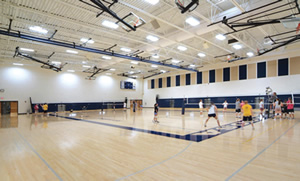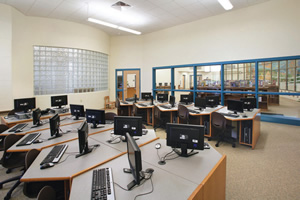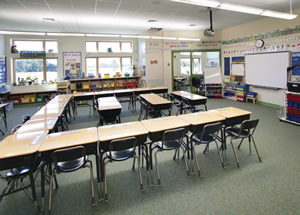A Battle Worth Fighting

PHOTOS COURTESY OF HOFFMAN LLC
In recent years, schools around the country have taken a beating from escalating energy bills. But, that doesn’t have to be your reality. Educational leaders can make a difference in their facilities’ performance by using some of the same approaches they utilize to enhance students’ performance.
For example, your team is sure to track and compare the standardized test scores of your students. It provides a benchmark to measure your students against others and evaluate how they are progressing from year to year. Testing establishes a standard by which to evaluate. But, do you measure and compare the energy use of your buildings? The often-quoted leadership phrase, “If you can’t measure it, you can’t manage it”, certainly applies in this context. It is an incredibly important first step to gather internal and external data. This will provide a framework by which you can forecast and measure improvement.
Data exposes opportunities
Initially, you should develop two primary resources. The first is the historical data of energy use for your properties, preferably over several years and with as much detail on each building as possible. And secondly, you’ll be looking for benchmarks to compare performance against expectation. Your historical data should be readily available through your accounting office or your energy provider.
Sources for benchmarking are likely to include your state education agency, www.energystar.gov/benchmark (available by building type), or other regional energy focused groups. In many parts of the country, there is wide access to free expertise through energy advisors. They are great sources of information and can provide wise counsel. In addition, these advisors can guide you towards resources that provide financial assistance to help fund the transition to a more energy efficient school. It is worth the time and energy to research what is available in your area.
Once you’ve assembled the data, you can begin to look for monthly performance patterns and compare those with your benchmarks. Benchmarks are most useful when they account for school type (elementary, middle and high school), the extent of air conditioning and summer use, the presence of swimming pools, and other uses in the building.
By comparing your electric and gas consumption on a per-square-foot basis adjusted for heating and cooling degree days with other similar school buildings, you can discover where you are doing well and where you aren’t matching up, identifying opportunities for savings. For example, if your electricity use is higher than comparable schools where air conditioning is not available, then lighting would be a serious suspect of waste.

PHOTOS COURTESY OF HOFFMAN LLC
Look at lighting
Sometimes, lighting energy over-use is a problem with a reasonably simple solution. You may find that lights are being left on inappropriately, spaces are over-lit, or that less-efficient lamps are being used. Many energy providers offer an electric lighting audit as part of a strategy to reduce overall energy usage. Some even offer financial incentives for converting to energy-efficient lighting. Assessment of the lighting levels relative to the visual task being performed is a vital consideration in this discovery phase.
Over-lit areas waste energy, while insufficient or poor quality light may reduce teacher and student productivity. An average of 40 to 50 foot candles is a good level for most classroom spaces and we often see much higher light levels in existing schools. (Foot-candles are a common unit of measurement in the lighting industry. Think of it as the amount of light that actually falls on a specific surface. The foot-candle measurement is equal to one lumen per square foot.)
For classrooms or offices focused on computer use, lower light levels are preferred by users. Lighting retrofits should focus on getting to the appropriate light level with efficient lamps. Lighting in vacant or sparsely used spaces can be reduced by installing time clocks or occupancy sensors.
Tame technology waste
When looking for “low-hanging fruit” in your pursuit to reduce your energy bill, take a look at your technology. Old computers and monitors can send the meter spinning day and night. Shutting them off at the end of the day and being sure sleep modes are in use are simple measures that quickly make an impact over time. Just ask the Hudson School District in Wisconsin. Their newest school, River Crest Elementary, was designed to be a highly energy-efficient facility. After construction and occupancy, the building was fully monitored, revealing that the school actually used less energy than the model predicted. The district then applied the techniques and strategies for energy conservation used at River Crest to the district’s remaining schools. The net annual energy cost reduction in the existing buildings across the district nearly equaled the annual energy costs to operate River Crest. Strategies that were implemented included lowering room temperatures, keeping lights off in low-use areas, and turning computers off at night.
In addition, some schools are moving to zero client monitors, which are server-based monitors for cloud computing systems. Zero-client monitors eliminate the need for local CPU (central processing unit), memory and storage at each individual workstation by connecting the monitor to a central server. These monitors execute responsibilities that are typically handled by a desktop PC. They not only reduce energy used by each of the individual stations, but also eliminate the heat that is transferred into the classroom or lab.
Snoop into your HVAC
As you compare your data to benchmarks, evaluating your heating, ventilating and air conditioning (HVAC) systems is the next place to turn as you become a super sleuth for energy efficiency. HVAC system operation plays a vital role in reducing energy costs and consumption over the lifespan of your educational facilities. Common remedies for excessively high energy usage related to your AC and heating include setting the temperature at a higher (summer) or lower (winter) level, timing the hours of operations such as shut off time more effectively, checking air filters, and utilizing shades more strategically. If those practices are already in place, then more complex steps — like examining verifying operation of heat wheels in energy recovery units, appropriate use of economizer mode, and checking the efficiency of the chillers — should be considered to remedy energy-eating system issues.
For more frigid regions of the country, looking at heating issues might provide the greatest prospect for savings. In addition to the above measures, examine if outside air is coming in unnecessarily during morning warm up when the facility is unoccupied. The age of existing boilers can often provide strong clues to energy efficiency. As a general rule, if you have condensing boilers up to 10 and 15 years old, you are likely to still be operating at a relatively efficient level. Good conventional boilers that are staged can still be operating relatively well if purchased in the last 20 years. Older boilers, especially those that were originally designed for coal or fuel oil, are likely to be very inefficient even if converted to gas. The payback on replacing such equipment should be evaluated carefully. Many schools are finding that adding a packaged boiler, if mechanical room space is available, is a cost-effective way to improve efficiency. Engaging knowledgeable energy professionals can be valuable to achieving long-term success once you move beyond simple solutions.

PHOTOS COURTESY OF HOFFMAN LLC
A Brighter Future. Hoffman LLC and Andersen Corporation designed a new prototype window for River Crest Elementary School in Hudson, Wis., that would control natural light levels, reduce glare and provide energy savings due to significantly reduced lighting loads. They also applied energy-saving strategies, such as turning computers off at night, to the rest of the schools in the district. The result was a net annual energy cost reduction in their existing schools throughout the district that nearly equaled the annual energy costs to operate River Crest.
Examining systems yields results
One recent project in Nekoosa, Wisc., illustrates the effectiveness of looking closely at one’s systems. Nekoosa High School (NHS), a 114,000-square-foot facility, was completed in 1970. Recently, the school district was ready for a 33,000-square-foot addition, and desired to add air conditioning to sections of the school that were without. They also aimed for holding energy use per square foot near the same level, even with the additional floor area and air conditioning. As we examined their systems, we discovered an antiquated and leaky pneumatic control system, old and ill-adjusted temperature sensors, and virtually inoperable control valves. In effect, we found a wealth of opportunity to improve the energy efficiency of NHS for years to come. Ultimately, they were able to add significantly more space and provide greater comfort for their students and faculty, while holding the line on energy consumption.
Windows wield results
Investigating the impact of your windows on the performance of your building is also important. Inefficient windows can not only negatively affect the performance of your building, but also the comfort and performance of your students. In too many instances, students that are close to windows are exposed to cold outdoor temperatures because of old, single-pane windows. Many technological advances have come to market in recent years that enhance the energy performance of windows while controlling glare. Examples include better edge sealing techniques, low-emissivity and solar control coatings, improved framing materials, low-conductance gas fills and edge spacers. These developments can be used to optimize each schoolroom’s performance based on climate and window orientation.
Stand up to rising energy costs
There’s no reason to be bullied by rising energy costs. Look at the available data and take the proper action to eliminate wasteful practices, update antiquated systems and become more efficient. Then, monitor the results to see that you get what you paid for, and identify even further opportunities to cut energy costs. Stand up to your facility and you’ll find the benefactors to be your students, faculty, staff and taxpayers!
This article originally appeared in the issue of .